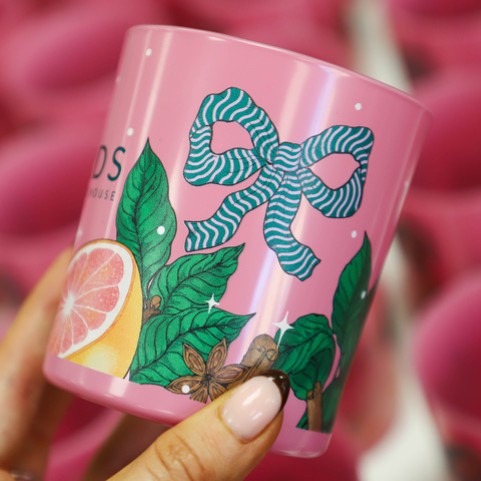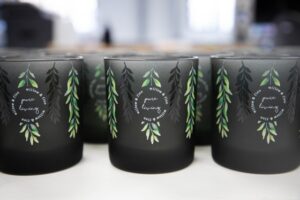- Equipment
- Inks & Supplies
- Services
- Applications
- Tagless
- Resources
- About Us
- Contact Us

Decorated candle holders are increasingly becoming a popular trend. As the candle market thrives, many consumers continue to allocate substantial budgets for home décor, a reflection of the lasting impact of remote work that persists even after pandemic restrictions have eased. With a growing desire to create ambiance and establish a relaxing environment at home, decorated candles play a vital role in this evolving landscape.
Candle making has its roots in the Bronze Age, evolving over the centuries with innovations such as the braided wick and advancements in the materials used for production. The process became industrialized in the mid-19th century when Joseph Morgan patented a machine that enabled the continuous production of molded candles. However, with the advent of the incandescent light bulb, candles gradually transitioned from a daily necessity to a decorative item.
As candles evolved into profitable decorative items, the need for effective branding emerged. One of the most cost-effective ways to brand candle holders is through adhesive labels, which many companies utilize to simply promote their products. However, as consumer expectations have grown, so has the demand for comprehensive information on candle labels. For example, in the 18th century, the rise of whaling led to the use of oil extracted from sperm whale heads in candle production—a practice that would raise serious concerns if disclosed on labels today.
Like all products, candles are subject to strict regulations that require specific cautionary labeling. These warnings inform consumers about the potential dangers of an open flame, such as keeping the candle within sight while burning, avoiding placement near flammable items, and keeping them out of reach of children.
As candles increasingly transition from practical items to decorative pieces, the expectations for candle holder design have evolved. High-end candle holders are moving away from adhesive labels, opting instead for full-color, seamless graphics that are printed directly onto the vessels.
For those starting with adhesive labels, it’s important to consider that even the most stubborn labels can be removed with heat. Therefore, choosing labels that adhere well is crucial, at least until the candle has completely burned down.
Digital UV Decoration on Candle Holders

Cylindrical Inkjet printers entered the market in 2009 and vastly improved the quality of cylindrical items being decorated on UV flatbed printers with rotary attachments. While this technology got the job done for quite some time, cylindrical printers quickly surpassed the quality and continue to innovate to create
Digital UV decoration for candle holders offers several advantages, including extensive customization options, exceptional image quality, and impressive durability, ensuring that designs remain vibrant and intact over time. The speed and efficiency of this printing method also allow for quick turnaround times, making it an appealing choice for manufacturers. However, there is a disadvantage to consider, such as higher costs compared to traditional labeling methods.
Adhesive Candle Labels
The adhesive candle label process begins with creating the label design, which involves selecting colors, graphics, text, and other elements that reflect the brand and product. Next, an appropriate label material is chosen, such as paper, vinyl, or specialty synthetic substrates, based on desired durability and aesthetics. The design is then printed onto the selected material using techniques like digital printing, flexographic printing, or offset printing, depending on factors such as order size and budget. After printing, the labels are cut to the desired shape and size, with additional finishing processes like lamination for enhanced protection against water and heat. The adhesive backing allows for easy application to the candle holders, which can be done manually or through automated labeling machines to ensure a smooth and even application. In some cases, labels may need to be cured or dried to ensure proper adhesion and durability.
Adhesive labels on candle holders offer several advantages, including cost-effectiveness, ease of application, and a wide variety of materials, making them an accessible option for many manufacturers. However, there are notable disadvantages to consider, such as limited customization options, the potential for damage from environmental factors like water and heat, and the difficulty of ensuring the labels are applied evenly. Additionally, the use of adhesive labels can lead to increased paper waste, raising sustainability concerns in the production process.
Comparison: Digital UV vs. Candle Labels
Inkcups is proud to offer digital cylinder printers designed to suit every production level. Whether you’re just beginning or have years of decoration experience, we can help you find the perfect machine to fit your needs, complete with seamless upgrade options for when you’re ready to expand. Say goodbye to the days of excluding digital UV printing from your business due to high costs. With the Helix ONE®, both small businesses and large operations can access advanced technology in a compact and affordable package.
On the flip side, if your business demands longer run SKUs, the Inkcups Double Helix® can keep up with these demands as it decorates two vessels at the same time. The full Helix line includes the Helix ONE®, Helix®, Helix®+ and the Double Helix®, each offering different output to make sure the needs of a wide customer base and volume demand are readily available.
The traditional use of labels and adhesives in packaging involves the consumption of additional materials, including paper, plastic polymers, and chemical adhesives. This reliance on extra materials not only escalates the demand for natural resources but also significantly increases energy consumption during production and application. Furthermore, these components contribute to a larger ecological footprint throughout the decoration process and complicate recycling efforts, making sustainability more challenging.
In contrast, UV printing onto objects eliminates the need for supplementary materials, allowing for a more environmentally friendly approach. This method enables containers to be disposed of according to their specific material guidelines, streamlining the recycling process and reducing the overall ecological impact. By adopting direct-to-object printing, businesses can significantly minimize resource consumption and enhance their sustainability efforts.
Photo Credit: Our customer, Bottled Goose. Read about how Inkcups machines have transformed their business here: Bottled Goose X Inkcups Customer Case Study.
Back to Blog Home
Add Your Comment